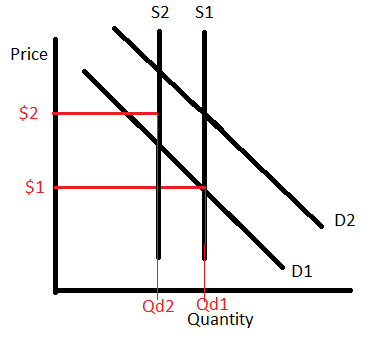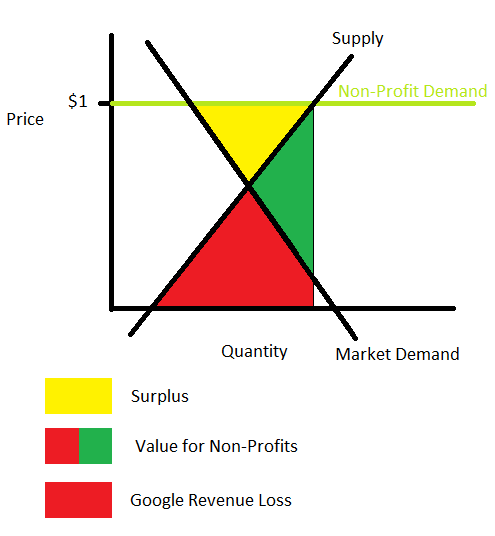- By: Mike LaLonde
- February 26, 2013
Google Grants: How Google Killed Non-Profits by Giving them Twice as Much Money
On January 28, Google’s new policy went into effect allowing Google Grantees to set a $2 CPC, rather than the $1 CPC maximum that had been in place since the program’s inception in 2003. The caveat here is that now non-profit ads “will now appear below the ads of traditional AdWords advertisers.” And it’s quite the caveat.
Look, the whole Google Grants program is a nice idea. But the $1 CPC limit of the past was a big problem, since it’s so difficult to find keywords that you can bid on for under $1. Google was generously giving all this money away, but it wasn’t money that non-profit institutions could spend. So when they announced they were bumping the price up to $2 I got a little excited – this could create a lot more opportunities to get exposure for our non-profit clients.
But wait.
I always like to ask myself “why?” when a large company makes a move like this. What’s in it for Google? Maybe I’m a cynic. Ok, I am a cynic. But I think I’ve got good reason on this one.
And here’s the thing. With the “now appear below traditional Adwords advertisers” clause in the recent policy, it doesn’t matter what the CPC is. Not one bit. It could be $2. It could be $200.
From a competitiveness standpoint at least. Of course Google still just gives you $10k/month ($329ish/day), so the only thing the CPC affects now is traffic maximization situations… which is actually WORSE for non-profits. More on this later.
Well, I have a degree in economics. I might as well use it a little. So here’s a chart of the previous situation with the $1 CPC max, competitive market for non-profits.
- The $1CPC policy essentially is creating a price floor on clicks at $1. After all, non-profits are willing to spend their money, so they’re going to just bid $1 on everything.
- Surplus represents what non-profits would be willing to pay with their grant money but can’t due to lack of click supply. Economically a surplus, but it’s really just a fake money surplus in this case.
- The green and red areas represent the value that non-profits get.
- The green area represents clicks that are available but no paying advertiser really wants them. So non-profits can scoop them up with no cost to Google.
- Here’s the problem for Google. The red area represents money Google is losing due to their philanthropy. Since non-profits can bid $1 on all these clicks and it’s a competitive, level playing field market, they’re going to outbid paying advertisers for these placements.
It stands to reason that an economist at Google saw the red area of the chart and identified it as an opportunity to make more money for the company. And he/she is correct. Non-profits are stealing away clicks where the equilibrium market price lies below $1.
So they came up with this new policy. Let’s check out my supply-demand chart on this one:
 Fancy, right? Here are the notes:
Fancy, right? Here are the notes:
- The price floor is gone. Since the max bid is now essentially just under any paying advertisers max bid, the non-profit demand must lie just below the advertiser demand so long as advertiser demand exists.
- Non-Profit demand jumps back to the Max CPC when market demand for the clicks is 0. Or, when advertisers don’t want them. The market for those clicks is now JUST non-profits. It doesn’t matter what the Max CPC is in this case, as all non-profits will be bidding it ($2 in this case).
- Surplus still represents all the money non-profits would like to use but can’t. It grew substantially.
- The green area represents what the non-profits get now. All the clicks that paying advertisers don’t want. I added S2, a second surplus line, because the original one would have shown no value for non-profits at all. S2 exists if we assume there is some click supply available that paying advertisers have no interest in… and the value nonprofits get is the are between the supply available and the advertiser demand line.
- There is no more red area. Google is now getting all of the revenue they can. The blue area represents that money they were losing in the previous situation that they have now regained.
- The blue area also represents the advertisers with a competitive market price CPC of less than $1 who can now get cost-effective clicks since they don’t have to compete with subsidized non-profits anymore.
WINNER: Google
WINNER: Advertisers with a competitive market price CPC less than $1
LOSER: Non-Profits
Even more interestingly, the move from $1 to $2 is really just a PR move. Which, by the way, everyone has been eating up. Most people reacted with excitement, anyways. In reality, all this really does is cut the number of possible clicks in half.
With this move, non-profits are simply going to be bumping max CPC’s from $1 to $2. Instead of getting a maximum of 330 people on that monthly budget, you can now only get 165. After all, we’re working with a fixed-quantity supply situation. As I’ve shown in the previous discussion, quantity supplied is actually going to DECREASE with this move as well.
 So, I guess you could say I’m not very excited about it.
So, I guess you could say I’m not very excited about it.
But there’s good news!
When has economic analysis ever been right about anything!? I’d like to maintain my Friedmanian right to change my mind. Or, in other words, in staying true to economist form I’ve made a number of supportive assumptions. Enough that, if I were you and you are someone running campaigns for non-profits, I wouldn’t be tying rocks to my feet quite yet.
This analysis assumes:
- There is no value for non-profits if competitive market demand exists. Meaning either advertisers are using all available space, or that the space they are not using is worthless.
- It is true market value bidding, without artificial floors. In other words, “below minimum bid” does not exist on keywords between $1-2 and so new opportunities exist.
Those are the important ones that I can think of that can give you some hope. In other words, those assumptions don’t hold true, but I feel comfortable making them since I think they will have a fairly minor impact on results. And by fairly minor impact, I mean I’m writing a blog here people, not trying to get my Ph.D.
What Should Non-Profits Do?
You should do what you have been doing, but keep in mind there’s a good chance you’ll be competing more against other non-profits now. And that’s a level playing field. Make sure your ads are landing pages are optimized for keywords, as any competitive advantage in that area will help.
Also, keep in mind that you might be looking at more side ad placements on keywords, so adjust your strategy accordingly.
